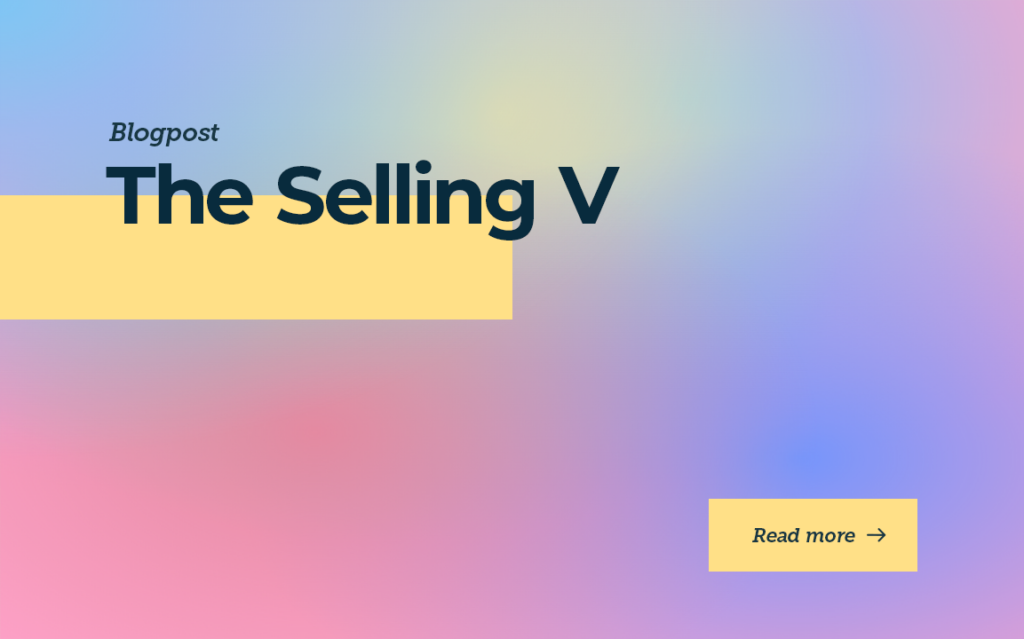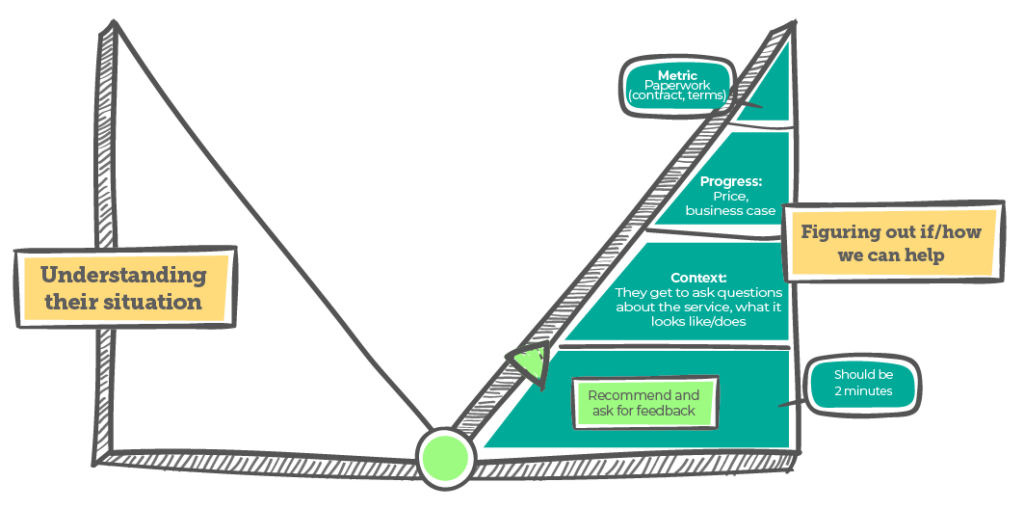The Selling V

Author: James Eudy – Account Executive at Predictable Revenue
What is the Selling V?
It’s a framework of questions to guide the discovery conversation between a prospect and a salesperson. At a high level, think of it visually as the questions narrow down to mutual understanding, and then back up with the offer and out with their questions about it.
Why should I care?
It’s not atypical for a sales call to be led and often dominated by the seller talking. After all, we are pushing our service or product.
However, just like in school, if the teacher talks too much, the students turn their brains off, or worse, death by PowerPoint.
Same here: to keep your audience’s attention, be a good listener and dig into it with better questions.
That said, it’s not a “check the box” framework. Otherwise, we’ve missed this last point: asking better questions must relate to an actively listened-to conversation. It’s more than waiting your turn to talk and noting what they say.
The Selling V questions are designed to orient your mind and guide it to a better conversation with a prospective client who will feel listened to and understood, at the very least, instead of just talked to. Which way do you think results in longer-term sales happen?

What is their context?
Again, this is not a question you jump out with to check the box verbatim. Try that at your own risk.
It’s a guide to giving you a start to the overall direction in which the discussion will naturally flow, and it assumes you’ve done even a fraction of rapport-building at the beginning. I could share what works for me here, but this depends on you, your offer, and your customer. Be sure to tailor it to your approach.
But to give you an idea, I want to understand where they are now, so I might ask, “How did you hear about us?” What would you like to cover in our discussion?” What prompted you to reach out today?”.
On a side note
Your prospective customer may not be used to having the space to talk and have come to the meeting expecting a slide presentation or to get straight to the price. It’s not uncommon for someone to ask me early on what the offer is and how much it is.
When that comes up, it’s best to respond with something like “happy to share that, there are a few directions we can go and to help me to get an idea of how we might help best if I ask you a couple of questions to understand your context, does that sound fair?” to keep it moving forward.
From my experience, this often depends on the title of the person I’m speaking to. If it’s a CEO, they built this baby and are happy to talk about how they built it and where they are today. If it’s the CMO, they go in a different direction than the CFO. Getting them started broadly helps grease the wheels as you push this boulder up the hill.
Our strategy is to build a picture of where they are today.
Understand who they are, their current process, and the team members involved. The current context also implies lessons they’ve learned. Did they try something last year that didn’t work out? What directions have they chosen previously that led them to consider you today, and further why and how? I can’t stress enough how important it is to avoid simply checking the boxes here and to let each point come out naturally.
Listening here is the key, not just hearing them talk. You’ll find that something will stand out, follow with a “You mentioned X, can you tell me more about that?” or “Can you unpack that for me?” and “Help me understand that” to offer a few and see what comes of it as you listen.
Once you feel you have the context. Test yourself. Summarize what they’ve said quickly and ask if that sounds right. If you missed, they’ll correct you and expand; if not, you’re ready for the next part.
Goals
The idea here is to understand where the customer wants to go. Almost everyone is open to talking about their goals. Compare this to simply asking your revenue and what you want it to be. That’s too rough. You might as well ask them how’s their BM; it’s too personal.
On the other hand, we’ve gotten to know their context and understand where they’re at from the previous section.
Now, we listen and dig into their goals and where they want to go. This is narrowing our field and dialing into the steps that come next. Once you feel you’ve got it, again quickly summarize it with something like “sounds like you’re at X and are trying to get to Y, is that about right?” and again, once they’ve confirmed that, you’re ready for what’s next.
Progress
How are they going to address those goals? The idea here is you are trying to understand what needs to change for them to reach their goals.
Based on everything from above to this point, it’s narrowed down and built to help you understand how you can fit into this picture and if you are a fit at all. Odds are, based on the knowledge of your company and its offerings, you’ll know what may be the best fit for them.
Take a breath, and think about your summaries. Give them a summary from 1, 2, and 3, and ask if you have it right.
Again, they may correct something to help you make the best recommendation possible.

The Center of the V
In this pivotal moment, establishing a deep connection is vital. It’s not just about hearing a “yes” but understanding the nuances behind their agreement. This is where active listening plays a crucial role.
By genuinely hearing your prospect’s needs and concerns, you can adjust your approach in real time, ensuring that your offer’s solution is heard and felt. This stage is about empathy, demonstrating that you’re not merely selling a product or service but offering a solution that resonates with their situation.
Recommendation and Feedback
After making your recommendation, it’s crucial to gauge the prospect’s reaction through their words, tone, and hesitations.
This feedback loop is where the art of persuasion gently nudges toward agreement. It’s beneficial to employ techniques such as mirroring their language and affirming their concerns, subtly aligning your offering as the solution to their expressed needs.
Here, the objective is to transform passive agreement into active engagement, leading the conversation toward a mutual vision of success.
Questions?
As questions arise, clarity becomes your most vital tool.
Each query offers a window into the prospect’s priorities and concerns. Addressing the price and business case, framing your response regarding value rather than cost is strategic. Highlighting how your service or product is an investment towards achieving their goals can shift the narrative from expense to opportunity.
Incorporating case studies or testimonials at this stage can serve as powerful social proof, reinforcing the credibility of your solution and smoothing the path toward a favorable decision.
Paperwork
Transparency and simplicity are key.
Often seen as merely administrative, this step holds significant psychological weight in cementing trust and commitment. It’s essential to ensure that your documents are clear, concise, and easily understandable, avoiding legal jargon that could intimidate or confuse.
Offering to walk through the paperwork together can demystify the process, addressing any questions or concerns in real time.
Additionally, highlighting key benefits and protections for the client within the contract can reinforce the value and security of their decision. Employ digital tools and platforms for document management to streamline this process, making it as efficient and user-friendly as possible. This approach facilitates a smoother decision-making process and enhances the client’s experience, laying a solid foundation for a long-term partnership.
Closing
Now you’ve made the journey through the V. Ideally, as you can see from the paragraph sizes, the V takes the shape of an inverted checkmark.
Heavy on the understanding side, meeting at the point of mutual understanding and bouncing back up through the recommendation and their questions, then unpacking that together.
There can be nerves involved in talking less and listening more. Most of us speak more when we’re nervous. Try this structure out; you might see why it works so well. Wouldn’t we all prefer to have someone to listen and understand us? Why not extend that to your customers?
Conclusion
The Selling V is more than a sales technique; it’s a transformative approach to engaging with prospects. It flips the traditional sales script, shifting from a monologue to a dialogue, where listening takes center stage. By delving deep into a prospective client’s context, goals, and challenges through strategic questioning, salespersons can craft recommendations that resonate personally, fostering a connection rooted in understanding and empathy.
This method is not about ticking boxes but genuinely comprehending the needs and aspirations of those we aim to serve.
Employing the Selling V means engaging in a dance of discovery and solution-sharing that aligns closely with the client’s vision, ultimately leading to more meaningful and lasting partnerships. This framework is a reminder that in the sales world, listening is just as critical as persuasion, offering a path to success that profoundly benefits both the seller and the buyer.
Connect with James to explore innovative solutions that can transform your approach to sales.
Ready for sales growth you can count on? We specialize in boosting your sales strategies for actual results. Let’s tailor a success plan for your business. Contact us today!

